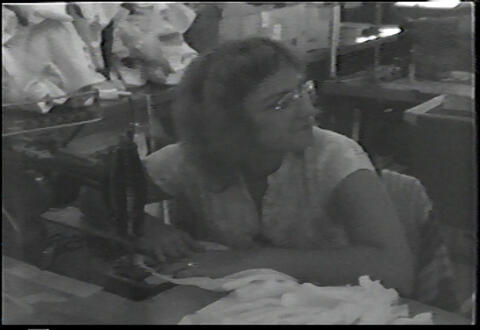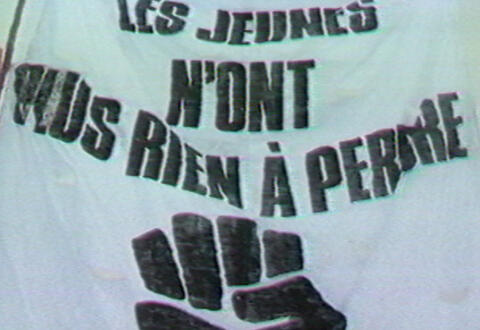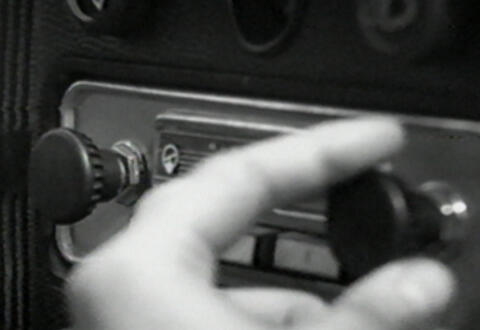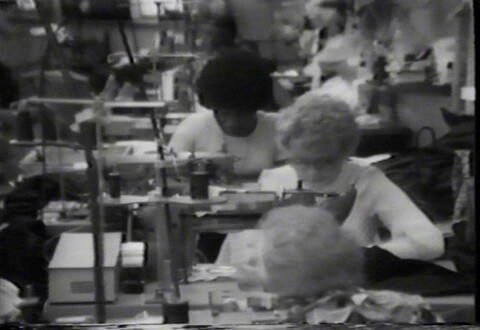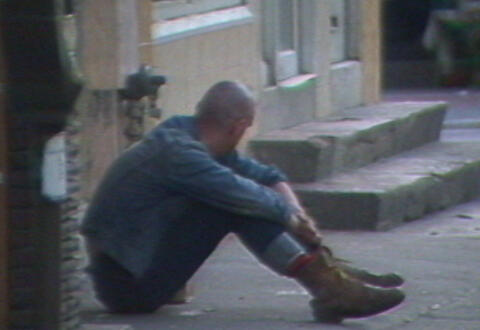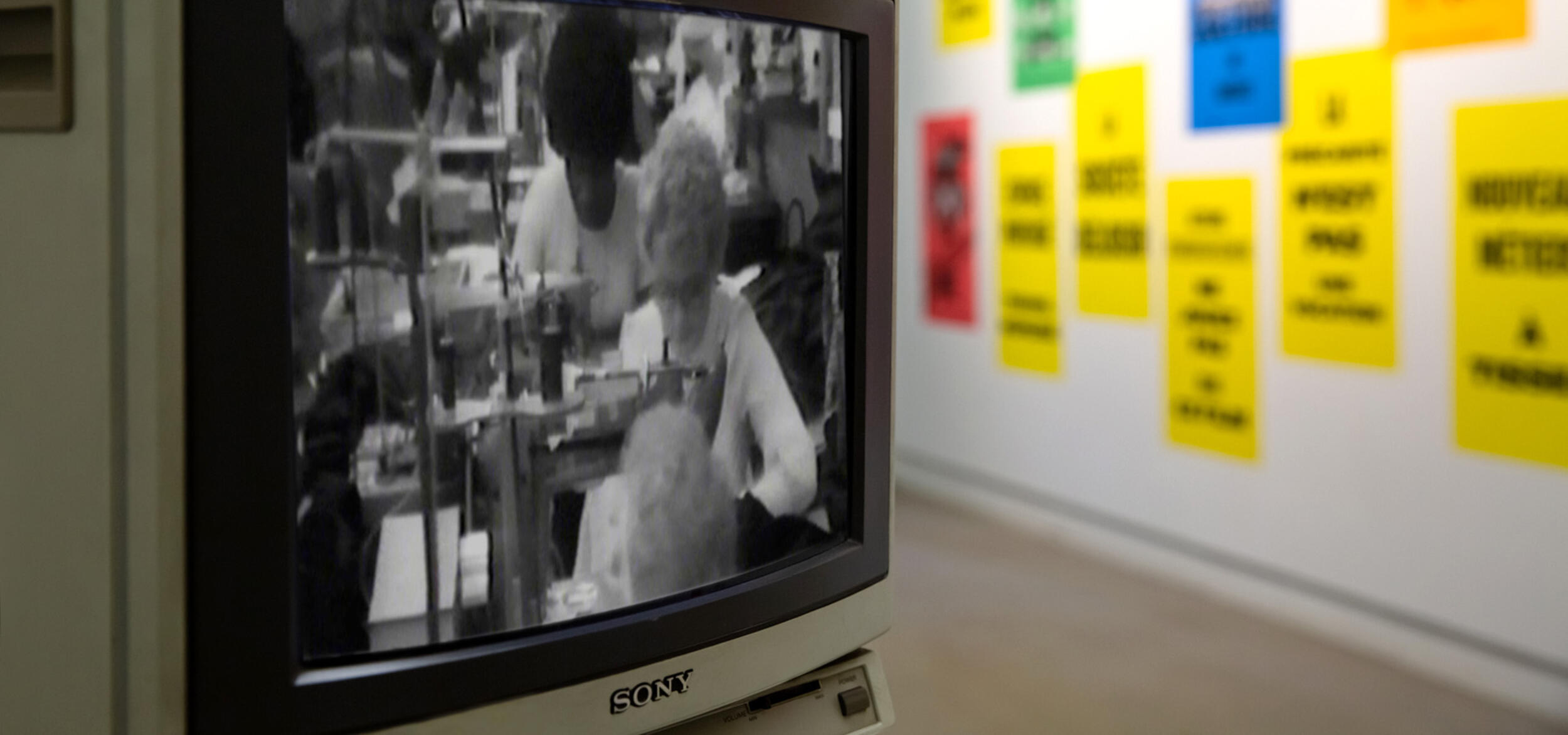
Exposing Work
By focusing on documentary videos or militant pamphlets showing the demands of workers in the 1970s-1990s, this essay offers an analysis of new ways of working and invites us to revisit the legacy of solidarity and of mobilization stemming from the working-class culture. This text was published as a poster-essay as part of the installation Afficher le travail (Exposing Work), shown at the Centre Diagonale from April 15 to June 5, 2021 and at the Musée d'art de Joliette from October 2, 2021 to January 9, 2022.
I make my living by designing movie posters. As an artist and researcher, I am interested in interrogating my own status as a freelance worker in the cultural industry through the subversion of advertising spaces (windows, billboards, construction site fences etc.) for artistic means. The installation Afficher le travail (Exposing Work) forms part of this study. As part of this project and a residency I carried out at artist-run centre Vidéographe in 2020-21, I have designed a series of posters based on selected video works in Vidéographe’s collection. These documentary videos or activist lampoons, which were made predominantly in the 1970s and 1980s, gave workers a vehicle to speak out against their working conditions in factories and manufacturing companies in Montréal and various Quebec regions. These men and women described their struggles and collective actions for emancipation, such as protests, the beginnings of unions and self-governing initiatives, etc. Despite the availability of these works on vitheque.com, their dissemination remains relatively limited. Beyond their archival value, how relevant would it therefore be to ‘reactivate’ these video works from another era through the medium of the poster?
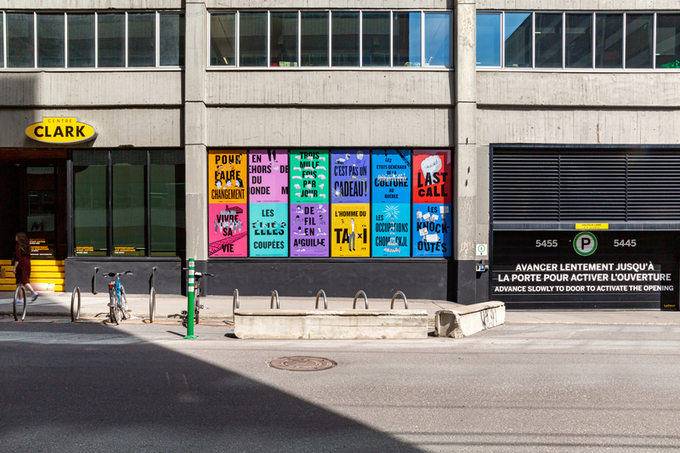
The posters paper the neighbourhoods for passers-by to see. Perhaps it is these neighbourhoods that should be studied. Today, many old industrial buildings are occupied by artists and workers in the ‘cultural industry.’ Despite significant changes in work and the reconfiguration of the urban ecosystem, these places remain historically linked to a community and an activism that we might want to draw inspiration from. Hijacked from their usual promotional function by the anachronism, the posters that I have designed are intended to renew calls to action to workers struggling in the context of the new modes of working. This text informed the making of the posters and presents a reflection on the recent mutations in the world of work.
LEAVING THE FACTORY
For a number of years, I occupied a workshop in an industrial building in Mile End, Montréal. The Industries Capitol building houses a foundry that is still operational in 2021, the other half of the building having been converted to house artists and other workers in the cultural sector, as well as in education and new technologies. With the globalization of markets leading to a decline in manufacturing, numerous manufacturers reduced production, emptied their premises and relocated to countries where production costs were lower. Between 1981 and 2006, the Quebecois metropolis lost 36,000 jobs in the textile industry while, during the same period, 35,000 jobs were created in Montréal in the IT services sector.1 Correspondingly, with the democratization and accessibility of media tools, culture and the arts began to take a more significant place in society. Cities in Quebec saw an opportunity for economic reorientation in these sectors. Many buildings that had previously been manufacturing sites were therefore converted into artists’ studios and cultural institutions. In Mile End, one example is the building situated at 5445 Gaspé Avenue, where artists’ studios and contemporary arts organizations are now well established.
A stone’s throw from this building, on the other side of the railway tracks, I was struck by the daily comings and goings at my old place of work, with the foundry workers going in and out of the building en masse through the door on the left at specific times, and the cultural workers using the door on the right at any time of the day. In seeing these silhouettes, I couldn’t help but think of a film that is often cited as the first motion picture ever made, La sortie de l’usine Lumière à Lyon [Workers Leaving the Lumière Factory] (1895), which portrays a crowd of workers crossing the threshold of a factory that manufactured photographic film. The invention of cinema symbolically marks the beginning of the exodus of workers from an industrial mode of production towards a cultural mode of production. This mutation does not however mean that the work has been eliminated, but rather that it has been dispersed into all areas of life.
In the essay, “Is a Museum a Factory?”2, artist Hito Steyerl underlines the irony in the converting of old industrial buildings. She remarks that 1960s political films that were produced and shown in factories as a form of social engagement and transformation, are today shown in museums (which are in fact the same industrial buildings, converted). Instead of considering this migration to cultural sites of dissemination as a form of neutralization of politics by aesthetics, their presentation in galleries should rather be received as a call to action for cultural workers – and those confronted with new ways of working – about their own working conditions.
In Amélie Leibl-Scholl’s 1984 documentary Vivre sa vie, an Italian immigrant and textiles worker says that, because of her work, she ‘doesn’t have time to live’. While, in her youth, going to the cinema represented a special occasion, this activity has become an integral part of her daughter’s everyday life: ‘Before, we didn’t go out, it was a special occasion if we went to the cinema. Now cinema, theatre, night clubs, they’re normal’. The worker suggests that the new generation has more freedom and independence and that they have more time to live their lives. Yet, in a consumer society in which merchandise has metamorphosized into the spectacle – and, in a way, the omnipresence of the image supplants the real – what does ‘live your life’ really mean? Today, what is all the more paradoxical with the rise of the digital economy, as philosopher Fanny Lederlin underlines, is that our – apparently free – time is more and more taken up with ‘working’ or ‘prod-using’, that is to say producing, consuming and disseminating data in responding ceaselessly to the demands of algorithms hidden in the apps on our smart phones, which command not only our fingers and eyes but also our brains. And so, ‘in transforming our free time into work time […], we let new forms of work destroy, not just our technical expertise and soft skills, but our understanding of how to live’. 3 We may have left the factories, but we haven’t left work behind.
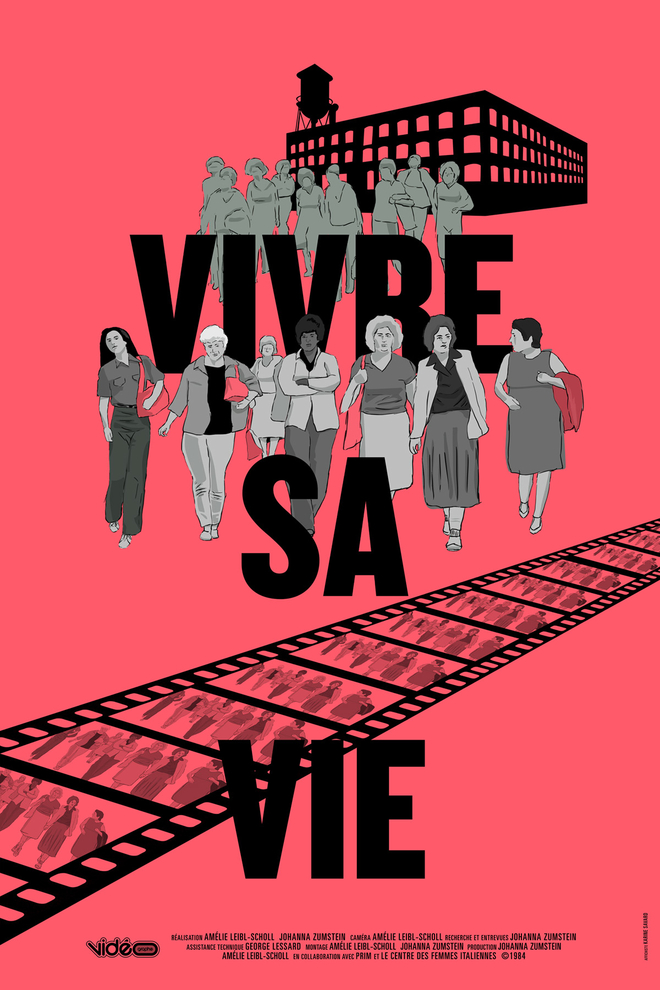
FROM ALIENATION TO SUPERHUMANISATION
The comings and goings at all hours of the day of these ‘new’ workers in ‘old’ factories reminds us that the boundary between working hours and free time has become increasingly porous. The video Trois mille fois par jour (1978) by Bernard Émond and Michel Van De Walle, about assembly line work in the textile and automobile industries, demonstrates the distinction between work (an activity carried out in exchange for a salary) and life (social life, leisure time, union involvement, and activism). In response to questions by the filmmakers, a worker in the auto industry describes his reality in the following way: ‘Life today isn’t about what you do at the factory but what you do outside of it, which is more important and rewarding. If you receive a good salary and vacation time, you go [to the factory]’. The worker, alienated by his work, repeats the same actions all day long and agrees to do this in exchange for time off and a salary – in other words, free time and the means with which to integrate a subjectifying dimension into his life that his work lacks.
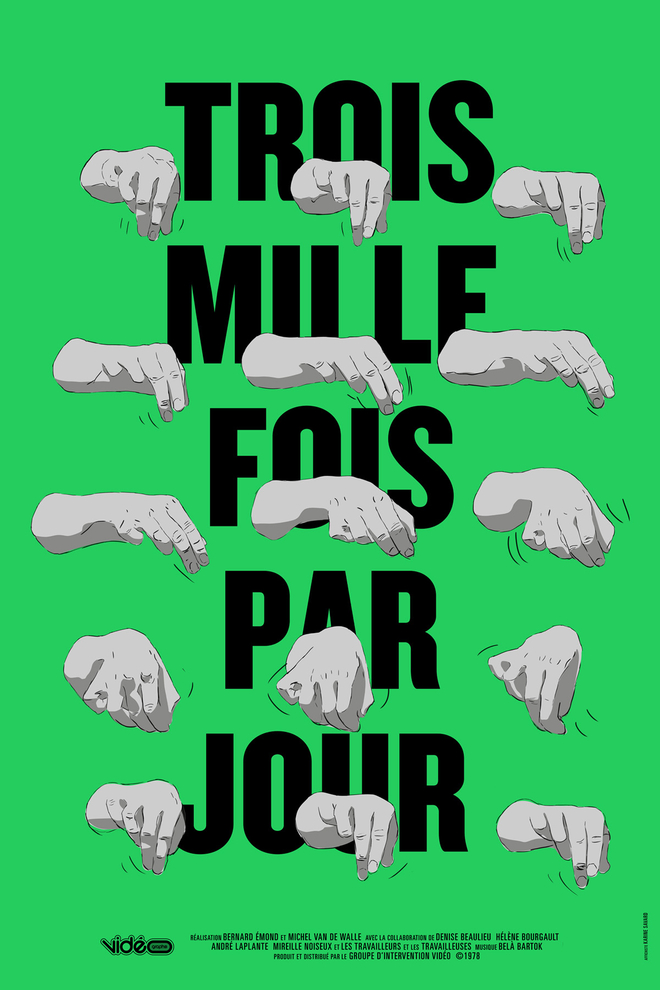
The principals of the Taylorist organization of work have perhaps allowed businesses to increase the pace of production but with them also came obstacles, such as absenteeism, high employee turnover, a lack of interest and, eventually, waning productivity. To counter these effects, businesses have slowly developed ‘human resources’ management techniques intended to render the work more attractive. In Bernard Émond’s video, a business executive presents an example of these methods. In order to make the repetitive nature of the workers’ tasks seem more appealing, he draws a parallel with hockey player Guy Lafleur, who has to practice daily to excel. From the 1970s onwards, this managerial trend has evolved towards what Danièle Linhart calls a ‘managerial super-humanization’, a new interest in the human element within a business. Companies began to slowly encroach on private life through the introduction of corporate social responsibility projects, leisure activities, sports associations, etc., to appeal to workers’ ‘altruistic propensity’ and ‘need to contribute to society in a selfless manner’.4 Consequently, they managed to contain any potential revolt, notably by appropriating the collective space previously occupied by union action and the activism of workers seeking emancipation and societal change.
In certain contemporary spheres of work, such as the cultural industry or ‘start-ups’, workers are no longer enclosed in the same space with a fixed work schedule, but instead have flexible schedules and see some of their leisure interests integrated into the professional arena (recreational spaces incorporated into the workplace and crowds of professionals enjoying ‘afterwork drinks’ in bars in the area). This interpenetration of private and professional spheres paradoxically contributes to a constant influx of work. Consequently, this also has the effect of eroding the space and time that could be invested in mobilizing and demanding better working conditions. In these new ‘creative’ professional spaces, it could be argued that the entirety of individuals’ subjectivity and their affect is absorbed by capitalism. In contrast to a period in which work consisted of assembling cars or using a weaving loom – an image of Charlie Chaplin trapped between the cogs of an assembly line in the film Modern Times (1936) springs to mind – greater perception is required to detect suffering at work because not only do the new modes of work render exploitation invisible, they even confer an attractive dimension to it. What if today’s exploited worker unexpectedly resembles the ‘liberated artist’?
PORTRAIT OF THE ARTIST AS WORKER
In the video États généraux de la culture au Québec (1973) by Jocelyne Laforce, a member of the group Jazz Libre, Yves Charbonneau, identifies himself not as an artist, but as a worker. ‘We are not artists. We use the word “workers.” The guys and girls understand that it’s a job. A production job. We see it in the revolutionary sense, not in the artistic sense of the term like the Ministry of Cultural Affairs sees it. It’s work. Therefore, a guy who works, is a worker. We’re in the cultural sector, rather than a factory.’ In the 1960s and 1970s, at a time when the worker represented the subject of emancipation, artists and intellectuals tried to abolish the divide between their world and that of industrial workers, between art and work. They wanted to participate in the workers liberation movement and, consequently, to interrogate the role of art in society. This identification with workers allowed artists to come together, reflect on their status and defend their rights and interests. With hindsight, some authors have criticised this approach, considering it artificially sustained. Despite these criticisms, the growing shift in notions of creativity, invention, freedom and autonomy – qualities linked to the artist – towards other spheres of work leads us to consider this parallel from another angle, looking, not at the artist as a worker, but at the worker as an artist.
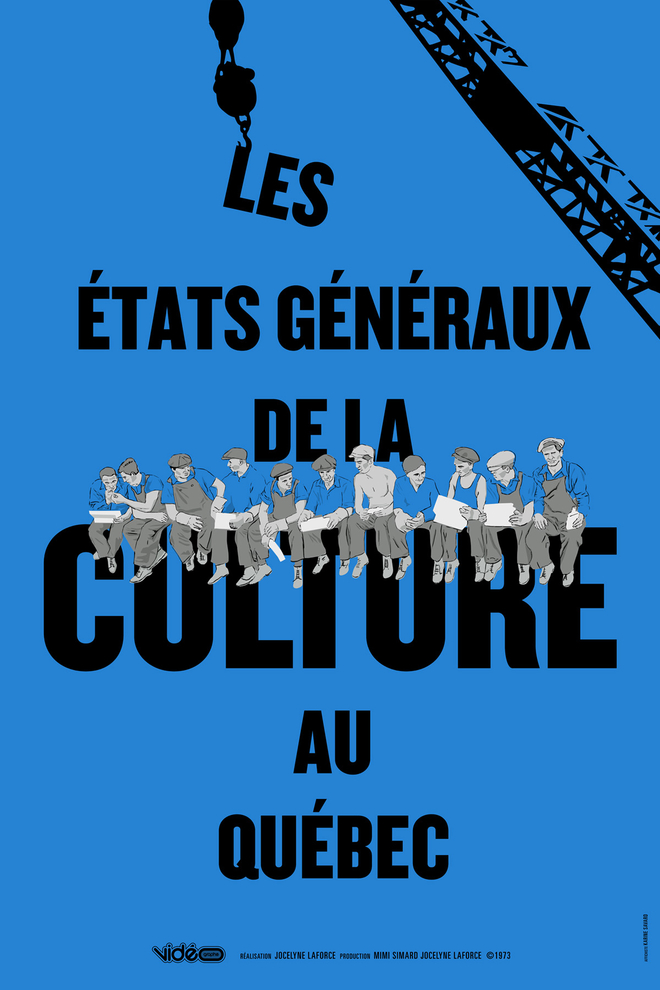
Indeed, it is the ‘privileged’ and ‘enviable’ figure of the artist that tends to be cited in the rhetoric used to promote the virtues of contemporary workspaces. While the values of artistic skill (imagination, play, improvisation, eccentric behaviour, creative anarchy) is shifted to different spheres of work, the precarious conditions linked to the status of the cultural worker remain obscured. The artist’s apparent freedom, which has become widespread in other spheres of work, often proves to be deceptive, the worker finding themselves without security, caught in an uncertain economy and more exposed to the risks of interindividual competition. In our society, we regard the ‘normal’ mode of creative practice as a ‘vocation’. 5 This romantic vision means that we see the artist as an individual whose commitment to their art is limitless, who derives a sense of accomplishment from personally identifying with their occupation, who earns a living in order to be able to make art, rather than meeting their needs through the act of making art. The figure of the creative genius – another romantic myth associated with the artist – means that we forget that, although some rare artists receive exorbitant sums of money for their works, the majority exist in disparate and often precarious situations.
In Portrait de l’artiste en travailleur, sociologist Pierre-Michel Menger purports that ‘not only are artistic activities not or no longer the opposite of work, but, on the contrary, they are increasingly claimed to be the most advanced expression of new modes of production and new employment relationships engendered by the recent changes to capitalism.’6 We could think, for example, of the system of contractual relationships through which artistic work is organized, imposing the model of project-specific production and collaborations. This model, which lends greater flexibility, now plays an important role for highly skilled jobs, while it has long been the preserve of less skilled jobs. As in the art world, the gaps in earnings become considerable and are socially accepted. Far from romantic representations, the creative practitioner will therefore be ‘an exemplary figure of the new worker, a figure with which we can also associate transformations as decisive as the fragmentation of the salary spectrum, the rise of freelancers, the magnitude and strength of contemporary inequalities or the individualisation of employment relations’.7
In the context of the COVID-19 pandemic, we might expect that the growth of remote working and the recourse to new technologies in different fields will accelerate these changes, which will need to be circumscribed to avoid workers becoming subject to new forms of exploitation. Different professional fields could be moved to act by the mirror that the cultural milieu holds up to them and by imagining new forms of union or collective groups in the neoliberal context. Philosopher Maurizio Lazzarato cites as an example the model of compensation and social security established in 2003 by employees in the entertainment business in France, which could be extended and adapted to all workers whose jobs have been discontinued. In sharing the particulars of terms of employment, unemployment and work in the arts sector, the cultural workers have created ‘a cartography of inequalities tracing new divisions that are not represented in any way in the established institutional framework’.8 They have indicated which battlegrounds would be suitable ‘to ensure both equality and autonomous mobility’.9 But this increasingly widespread reality does not mean that the new workers form a homogenous mass.
CREATIVE CLASS OR CLASSLESS WORKERS?
However, the idea of a ‘creative class’10 has appeared in the rhetoric about the development of cities and regions. This class is made up of workers from arts milieux, creative, information and high tech industries, and basic and applied scientific research fields. But the real existence of this ‘creative class’ is called into question, notably by the artist and author Martha Rosler.11 Rather, this new ‘creative class’ is a socioeconomic class used ideologically in the neoliberal context to justify the interest of investments that drive city transformations. Post-industrial cities that are artistically dynamic and culturally popular are more attractive to businesses and tourism, strengthening their economic development. Rosler underlines the ambiguity of this group, which is not a homogenous entity. The new professions of the creative sector (culture, visual arts, theatre, dance, photography, advertising, media, fashion, etc.) manifest themselves through heterogenous situations (different statuses, salaries, social security cover, workload, duration of work, etc.). Many of the people who work in these sectors are vulnerable, poor, uninsured, without safety nets, and yet are included in the ‘creative class’ category along with high tech fields, which are much more highly paid.
Ironically, while culture holds a central role in the identity of the new technological city, cultural workers contribute to the gentrification of areas that, at one point, they will no longer be able to access. Considered in 2011 as ‘the most highly populated artists quarter in Canada’,12 Mile End now paradoxically sees its artists (like immigrants on modest incomes) become slowly dispossessed of an area that has become more attractive thanks to their presence. In 2019, when I left my studio, a start-up business dealing in low-priced air travel moved in.
From my studio window, I remember looking down on random tracks in the freshly fallen snow. The footprints left in the winter snow by workers and passers-by in the neighbourhood crossed the continuous straight lines of the railway tracks. The frequent, illegally used, openings in the fence running alongside the railway tracks are revealing of the maladaptation of this industrial vestige to the current logic of the area. The contrast between the unique perspective of the rails converging on the horizon and the trails made by passers-by leading to multiple destinations is somehow analogous of the current scattering of workers who are free and mobile, but also precarious and disrupted by the loss of traditional categories of work that previously offered a common perspective. The disappearance of structured social classes renders more fragile many workers who find themselves ‘reduced to a sum of scattered, vulnerable individualities, aware of their social downgrading and deprived of a social space in which to act on, even fight against, this awareness’.13 These workers are cut-off, classless, atomised, de-socialized, with reduced subjectivity, and they increasingly face new types of work and the flexibilization of the job market. Are we therefore forced to live our lives in a ‘decomposed world in which everyone is caught up with their own difficulties, obsessed with their own problems, and developing an indifference to others’14 ?
In order to recognize the difficult conditions linked to their status and to take action, the ‘de-socialized’ workers must first find the time, the focus and the means necessary. Personally, I have become aware of this growing individualization in my line of work designing movie posters, which fosters the emergence of individual competition over fraternal collaboration. Like a large proportion of the advertising sector, design commissions for movie posters are often won by pitching ideas. In this method, three or four designers are commissioned simultaneously. In exchange for a small fee, they are invited to propose 10 visuals exploring different ideas. At the end of this process, only one concept is retained and one person properly paid. Over time and with the recognition that I have gained for my work in this field, I have gradually begun to circumvent this process by choosing to work on projects that, although sometimes less lucrative, favour a relationship of trust. My output tends to be of a higher quality when I am working on a project in which I feel that my contribution is important and in which there is some dialogue and exchange, than when I am competing with peers. My desire to continue to practice a line of work that I love and in which I have developed an expertise has caused me to start to worry about being pulled down the individualist path by current neoliberal tendencies.
PIECEWORK
On several occasions I had the opportunity to carry out research at the Centre internationaliste Ryerson, a library specializing in Marxism, political economy and the history of the workers’ movements. Until recently, this collection of books, bequeathed to the Fondation Aubin by historian Stanley B. Ryerson, was housed in one of the megastructures built long ago to welcome textiles manufacturers in Mile End. From the entrance to the library, we could still see workers leaving a clothing manufacturer that remained operational until 2018. Before the library was evicted in 2019 to house a more lucrative tenant, fly posters appeared in the area, not without irony, to promote the premises as a coworking space. In order to remain financially viable and maintain its activities, the Centre internationaliste Ryerson sought to imitate these new workplaces that proliferated in the area and offered ‘workspaces by the day, the hour or the month, in an area that is overflowing with tech start-ups and various organizations in the arts, fashion, food, software and video game industries’.15
The library finally moved to the Centre-Sud neighbourhood. The new workers who have moved into its old premises would, however, have benefited from using it, as the digitalization of work has brought about new forms of certain constituent issues of industrial work already theorized by Marxism. For example, consider the principal of piecework, which is strongly criticised in the textile industry. While a salary is based on the length of time worked, the pay for piecework is determined by the task to be accomplished. This form of remuneration can seem more advantageous for the worker in giving the illusion of granting more freedom or of them being their own boss. But with this tâcheronnage16 (pieceworking), the individual isn’t in a position to negotiate their terms. They are deprived of the power balance that the group procured for them. From this point on they are in competition with others, and they are obliged to perform better if they want better pay. They are no longer exploited by their boss, they exploit themselves. The video De fil en aiguille (1979) by M.K. Emre and Magaly Sala-Skup, which documents the reality of work in the textile industry, highlights the relationships that are woven between the workers. In the video, they qualify piecework as a tue-monde [drudgery] that ‘should be abolished’. On the other hand, they say that solidarity can be more advantageous to them: ‘Sometimes, you stand up for someone, and it’s going to come back to you. If you stand up for a girl, with something that makes sense, you stand up for yourself, your rights. All alone in a corner, what are you going to do?’
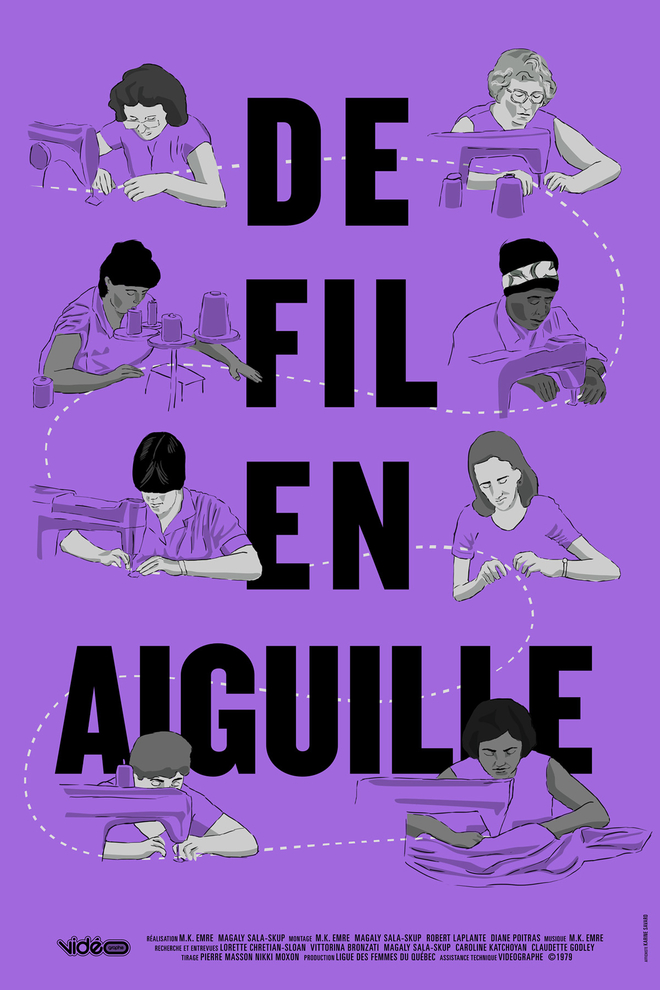
Similarly, in the absence of direct subordination in the taxi industry, we find an illusion of freedom comparable to that which pieceworking seems to offer. Without an employment agreement, the taxi driver finds themselves without social security, a pension, vacation, and sick leave, all while working long hours for low pay. In the video L’homme du taxi (1973) by André Girard the drivers interviewed talk about, among other things, ‘spears’, individuals such as students, construction workers on winter unemployment benefit or family men looking to make a bit extra at the end of the month, who drive taxis temporarily, hindering the establishment of regulations that would humanize the working conditions of this industry. With the development of online platforms, the new taxi (and delivery) driver has become emblematic of the isolated worker in the neoliberal system. We need only think of Uber, a lucrative enterprise that increases its profits by circumventing legislation and not granting drivers the status of employee. Drivers are therefore deprived of the social benefits and job security that being a salaried employee would bring, without receiving the advantages of entrepreneur status that they claim to give them. This is an illusion of independence that an increasing number of workers are experiencing.
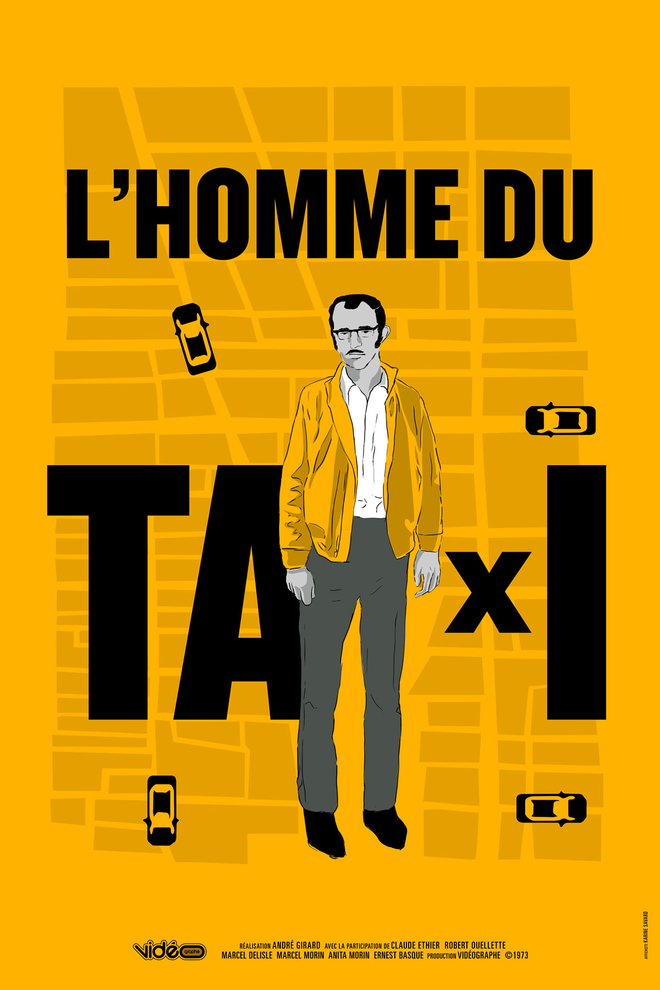
ENTREPRENEURS OF OURSELVES
As a counterpoint to the migration of the lexical field of arts towards entrepreneurial spheres, we also see the use of business vocabulary in public, social and educational spheres, and overwhelmingly in cultural spheres. In 2015, during a ‘day without culture’17 – a symbolic strike aimed at bringing cultural workers together for a day of reflection – many raised the emergence of entrepreneurship in the art world as one of their concerns. The transformation of independent working to entrepreneurship puts undue pressure on artists, who have to not only obtain the recognition of their peers, but also need to gain skills in career management, administration and marketing while developing audiences and diversified sources of revenue, even having to create jobs. And yet, the values associated with entrepreneurship (growth, profit, delegations of tasks, etc.) does not go with all types of independent working. From a neoliberal point of view, ‘a larger pool of artist-entrepreneurs means a greater number of passionate, resourceful individuals who are willing to fight against all odds to create their own opportunities, fostering a deregulated environment of innovation and economic growth as well as decreasing demands and expectations for non-entrepreneurial subsidies. Such a climate is bound to put increased pressure on cultures of mutual aid and political organizing that exist in the arts already’.18
We can take this even further, if we look at Byung-Chul Han’s essay The Burnout Society and say that we are all destined to become ‘entrepreneurs of ourselves’. According to the author, we will have passed from a ‘society of discipline’, in which individuals were constrained by obligatory work – the factory for example – to a ‘society of performance’ in which the subjects interiorize the responsibilities of work themselves (which we pass off as something else, such as entertainment, leisure or an engagement).19 We now work because we can ‘do it all’. While we are unhindered and only listen to ourselves, we are confronted with a new form of exploitation that is a lot more pernicious and that can lead to burnout. Philosopher Maurizio Lazzarato shares this opinion, purporting that the individual must now ‘ensure their own training, development, accumulation, improvement and valuing of ‘self’ as ‘capital’, through the management of all their relationships, choices, and behaviour according to the logic of the ratio of costs/investments and the law of supply and demand’.20 In this way, the ‘de-proletarization creates a leap forward in the discourse (“all owners, all entrepreneurs”) but it becomes the contrary in reality, notably because of lower pay and budgetary cuts in the welfare state. The economy of debt organizes an economic and existential precarity that is the new name for an old reality: proletarization, particularly of middle classes and workers in new professions.’21 In the current economy, cuts to the state in health, education and culture seem to confirm that we find it difficult to recognize the value of certain types of work, should they not conform to the logic of capitalist productivity, i.e. the production of higher added value captured in the form of profits.
THE VALUE(S) OF WORK
Norman Thibault’s 1985 film Les elles coupées highlights the aporia of budgetary cuts and its consequences on care workers who are often unseen and receive little recognition: ‘[the] government, when they opted for spending cuts and reduced services, weren’t losing, because they know that someone in society (and this someone is often a woman) will do the work and do it for free’. It is even more paradoxical that it seems to be accepted in our society that the social value of work is inversely proportional to its economic value. This seems to suggest that the more of a service the job provides, the more beneficial it is to society or gratifying on a human level, the less we will be paid for doing it.
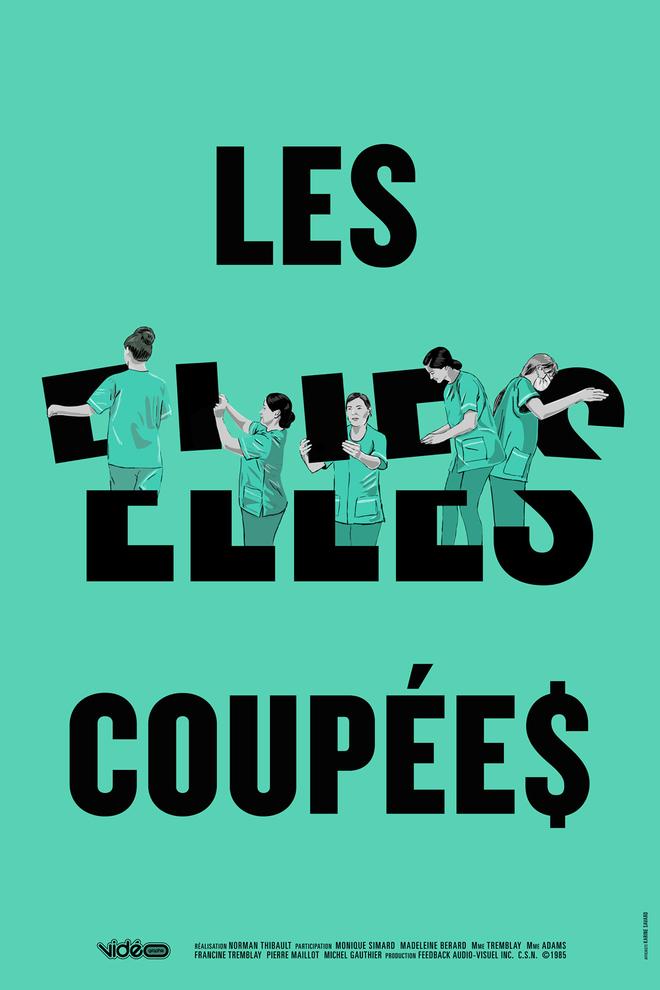
Anthropologist David Graeber explains in Bullshit Jobs that this moral judgement stems from, among other things, a vision characterized by the patriarchal system of the theory of labour value. This rests on the hypothesis that the real value of goods is generated by the human effort that was required to create them. In other words, wealth is created by work. But what we understand by ‘work’ is often reduced to ‘productive work’, i.e., work that creates a plus-value (a surplus of unpaid work) captured in the form of profits by the capitalist economy. In this way, we obscure the economic dimension of what is considered from a feminist perspective as ‘care work’ or any form of ‘attending to’. Graeber points out that ‘we refuse to see that the laborer’s work, whether it is accomplished by men or women, consists less often of hitting a hammer, cutting stone, lifting heavy loads or harvesting fields than tasks that we typically see as feminine: taking care of fellow human beings, trying to respond to their demands and needs, to explain, to reassure, to anticipate the desires or thoughts of superiors, but also everything related to the care, surveillance and maintenance of plants, animals, machines or other objects’.22
In the video Pour faire changement (1974), which gives a voice to workers at the multinational Firestone in Joliette, filmmakers Tahani Rached and Larry Mead document the actions and speech of workers during their strike action, as well as that of their partners. One of them expressed herself this way: ‘We have realized that women are also exploited, even when they take care of the home. In doing housework – which means supporting [the husband] (feeding and dressing him, giving him children) – all that goes to the company. We are not paid for this work’. Women, in following the same training on trade unionism and workers’ rights as their partners, came to understand, not only the struggle for their husband’s emancipation, but, above all, the necessity of their own emancipation.
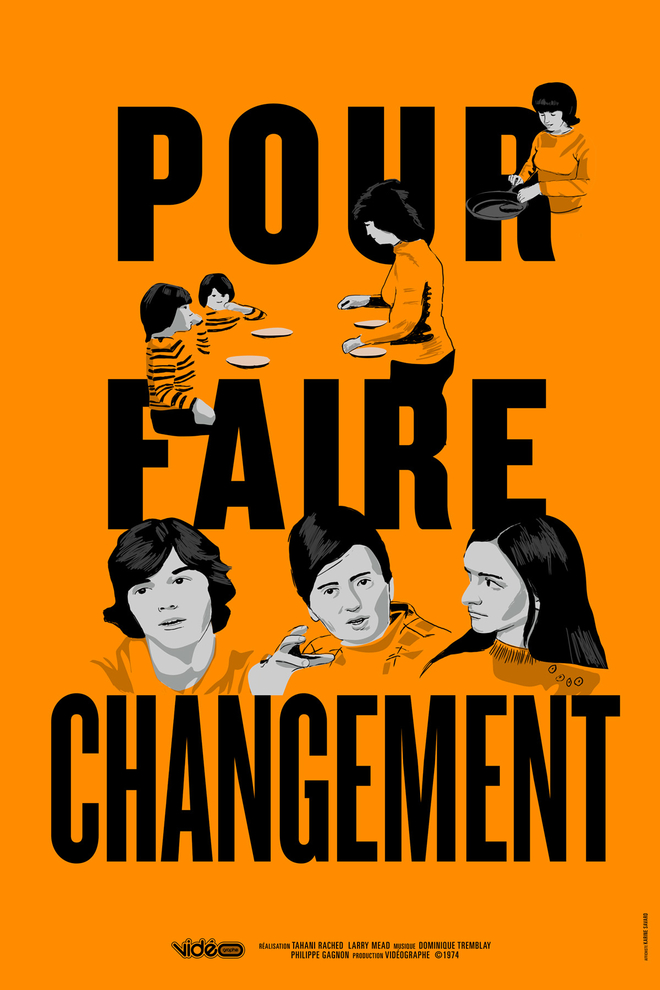
This issue of non-payment for work and the way in which it is inscribed in our institutions has been addressed in Ève Lamont’s video En dehors du monde (1994). It denounces government employment programs for encouraging the keeping of certain individuals, many being care workers, outside of a viable social space. The documentary presents, for example, welfare recipients who are obliged to take part in government incentives for fear of losing their social security benefits. They do volunteer work, often for community organizations, such as food banks or home help for senior citizens. The associations operate on tight budgets, and they are obliged to use employment support programs. Many businesses 23 also benefit from this free labour. They can easily abuse of the situation by forcing candidates to carry out repetitive and degrading tasks and letting them go at the end of their ‘training period’. Certain organizations set up a code of ethics (rights of individuals, training, vacation, participation in decision-making, etc.) but, despite this, these programs keep individuals in a precarious position.
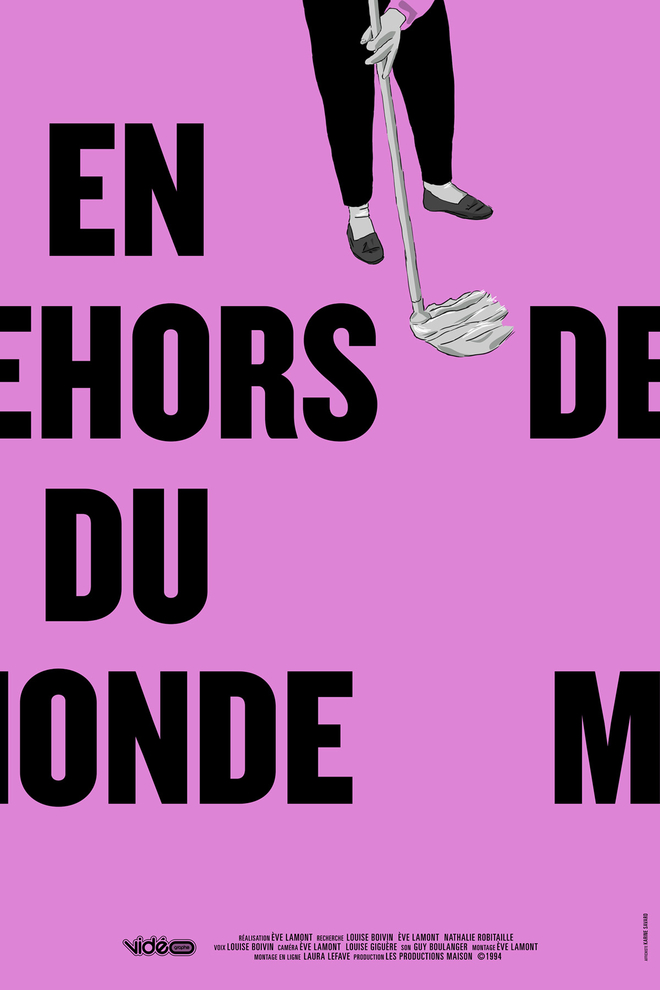
In the cultural milieu, in which money is also tight, certain jobs that are subsidized by similar programs also come with meagre salaries and temporary contracts. In addition, many posts with insecure conditions at artist-run centres are held by women. Other programs contribute to keeping artists in a continual ‘emerging’ status, which brings continual instability. However, difficult conditions (poor revenue, difficulty in finding permanent posts, inadequate funding for the production of artworks and exhibitions, etc.) are not linked to a lack of willingness, skills or expertise. They are rather due to the fact that, in our society, the work in the fields of art, education or health is not considered as valuable in and of itself.
THE LEGACY OF WORKING CLASS CULTURE
In a context in which the values of mutual aid increasingly become values of performance and personal success, the title of the video Last Call (1972) by Michel Dumont could be read as a call to look back at the history of the working class and the heritage of solidarity before it disappears completely. Although they occupied a central place in social history, the issues concerning the working class tend to disappear in reflections and discussions about work. As we can see in Dumont’s video, workers’ awareness – in this case workers in the mining, furniture and textiles industries in the region of Bois-Francs – vis-à-vis their conditions and the necessity to mobilize builds slowly, with time and effort. If the transformations of work have rendered the working class ineffective as a historic agent of emancipation, we can ask ourselves how the working culture can be envisaged as a permanent legacy reinforcing a common identity among new workers.

For William H. Sewell, the origin of the ‘working class’ predates the development of factories.24 It would have emerged with artisans under the Ancien Régime [Old Regime], at a time when they were beginning to organize their work within guilds and corporations. Awareness about worker’s conditions was then associated with words relating to the idea of unity, such as association or fraternity, rather than terms indicative of social hierarchy, such class. In a willingness to preserve their expertise and to continue their practices, these artisans would have tried to establish a system in which work – manual or cognitive – rather than ownership, would be the encompassing, defining feature of the social order. This culture would, as it continued to develop with the working class into the industrial era, have been a counterpoint to the dehumanizing working conditions in the factory. In this sense, if we are not able to count on the trade union structures to unify the ‘classless’ new workers, these later could at least look to the working class culture to build networks between themselves.
The video C’est pas un cadeau ! (1975) by Tahani Rached gave a voice to workers and retired workers from the Alcan factory in Shawinigan, bringing together the generation of active workers in 1975 with those who had been responsible for the establishment of unions in the preceding decades: ‘You, the little guys, have had that readymade. The unions – we started those. It was difficult for us because it was forbidden’. Yet, the title of Rached’s video suggests that, despite the union struggles led by workers to improve their situations, workers’ conditions remains unenviable. One worker indicates this in saying that he did not wish to pass this legacy on to his children; he would prefer them to study to build a better future. Although the current generation had better access to education, certain values such as solidarity, sharing or mutual aid – which contrast with those promoted by the current rise in neoliberalism – seem to have been lost.
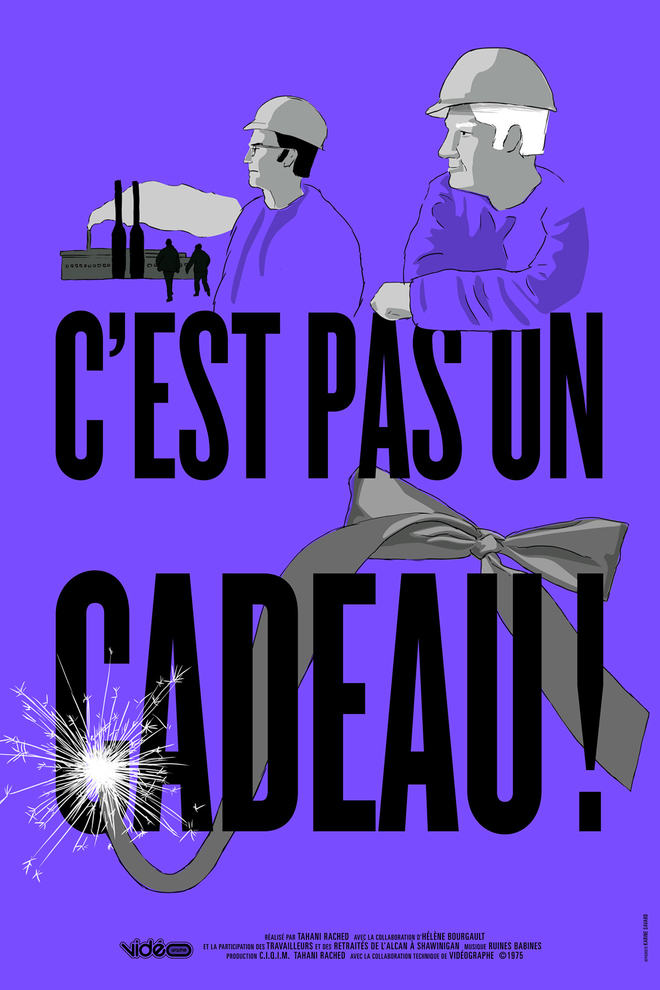
Personally, access to education allowed me not only to satisfy a thirst for knowledge, but also to discover a world that seemed to me at a certain time more attractive than the world that I came from. My parents are not factory workers or miners but they do manual work: my father is a carpenter-joiner in the building trade (his father was a taxi driver) and my mother is a hairdresser. In her novel La place, Annie Ernaux describes the way in which, at a certain point, in migrating to a middle-class world, everything that was close to her became foreign, the ideas of the world that she was from began to seem ridiculous. She therefore decided to write to remember ordinary life, her father’s gestures, tastes and ways of speaking, an existence that she shared but that she had learned to forget. She denounces the violence of her integration into this world in which she has entered and, through writing, tries to ‘update the heritage [that she had to] leave at the door of the cultivated and bourgeois world when [she] entered it’.25 I remember feeling anger and confusion similar to that described by Ernaux, in not feeling at home in either the intellectual and cultural milieux into which I had integrated, or the social milieu that I came from. To reconcile these two ‘worlds’ and find my place, I invited my father to create and display posters with me in the city. I grew closer to him and was particularly interested in the gestures and expertise that his work involved, while he learned about my practice and the knowledge that relates to it. This collaboration, anchored in a human relationship and in a pooling of our respective expertise, gave meaning to my work. In a work context in which the over-investment of the individual leaves very little space for this collaborative approach, it seems essential to revive these values of solidarity that have gradually disappeared from our lives. Byung-Chul Han points out that the ‘neoliberal subject [this entrepreneur of the self], has no capacity for relationships with others that might be free of purpose. Nor do entrepreneurs know what purpose-free friendship would even look like’.26 The total isolation that neoliberalism brings does not give us freedom. According to the philosopher, (real) freedom is all about ‘relationships’.
The poster that publicized the screening of La bataille du bois (1972), by Denis Bélanger and Michel Benoît depicted this type of fraternity well. The title is surrounded with vertical lines from which interweaving strokes emerge, which symbolize the criss-crossing of roots and branches in a forest. The visual recalls the solidarity that binds the residents of the small town of Cabano, in the Bas-Saint-Laurent, who are invested in a cardboard project in the form of a cooperative. The aim of the project is that, by inviting the future workers to contribute to its financing, they will also benefit from its future profits. At the same time, a management philosophy based on solidarity is established. This collegial approach led to the establishment in the 1970s and 1980s of numerous artist-run centres, which now form an integral part of the arts milieu.
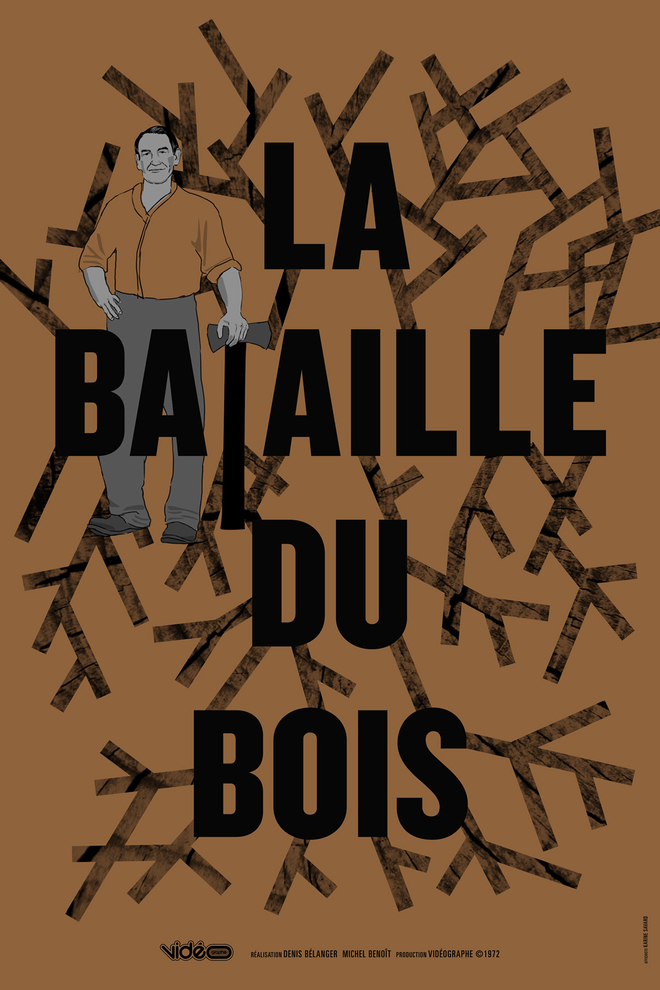
OCCUPATIONS
Several years ago, when I was doing a residency at the audiovisual production centre Daïmôn in Gatineau, I was struck by the sight of a quantity of video and audio equipment wrapped in garbage bags and stored in the basement of the building known as ‘La Filature’. This building, which has housed artist-run centres Axenéo7 and Daïmôn since the 1980s, takes its name from the old wool mill, George E. Hanson. This pile of obsolete video tools contrasts with the dematerialized digital tools used today. They can now be combined in a single computer and are linked to remote IT servers via networks (clouds). This change certainly offers greater accessibility to work tools, but we can also consider the disadvantages of such a metamorphosis, such as professional and social isolation, hyperconnectivity and a lack of respect for private life. Previously, the significant cost and weight of video tools necessitated a pooling of resources and a shared space, which fostered the development of communities, meeting places and exchange. Coworking spaces and cafés, while facilitating a momentary breaking of isolation for new workers, remain places of mingling but not convergence; places where we meet individually but rarely collectively.
The term occupation, from the Latin occupare, signifies the thing to which we dedicate our time – an activity, a task, a job – but also means taking possession of something, appropriating a place. The video Les occupations CHOM, CKJL (1972) [anonymous] documents the occupation of the radio station CKJL, in Saint-Jérôme, by its employees in a demand for better working conditions. At one point in the video, the strikers consult a newspaper and become aware of an intervention by a Common Front delegation of workers. On 14 May 1972, by way of a protest relating to the PQ’s position on their demands, these workers decided to occupy the printing press of the newspaper Québec-Presse and to force the publication to pull Jacques Parizeau’s column, leaving a blank page under the heading announcing the usual column. Imposing a void in a very powerful media space is another form of occupation. Later, other protesters managed to occupy the airwaves of the CHOM radio station in Montréal and call for the population to ‘take the means of communication that belong to ordinary people’.
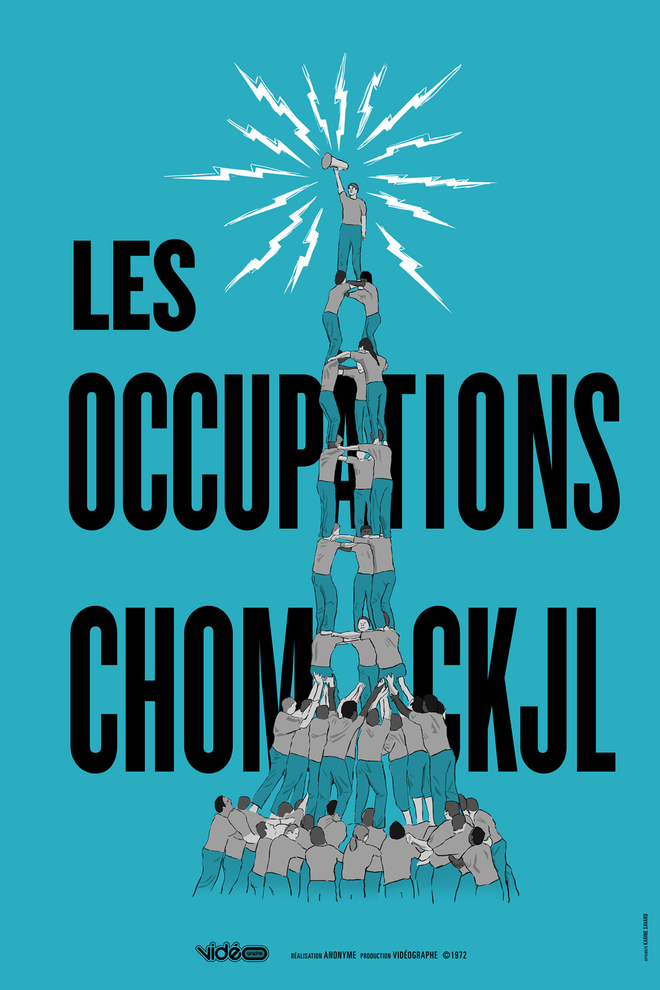
The poster is one such means of communication. Without requiring many resources and with the ability of being disseminated directly into the urban environment, the poster was omnipresent in the workers strike movements and occupations. Lyse Chagnon’s video Les Knock-Outés (1971) tells of how the daily newspaper La Presse, at the point at which the collective employment agreements of around one hundred unionized workers expired, imposed a lock out to the newspaper’s typographers. The title ‘Knock-Outés’ therefore referenced the ‘lock out’ as an attempt to shut down confrontation. These employees’ jobs entailed compositing texts and images for print, which could be seen as formatting the words of power. Deprived of their work tools, they created posters as vehicles with which to make their voices heard. Their hand-drawn slogans read: ‘We don’t have the boss that we deserve’, ‘La Power, end this farce’, ‘La Power wants to break up unions’, ‘To be happy/be assholes/it’s what La Power wants’, ‘People help us out / don’t buy La Presse’, and, when they finally managed to emerge from this seven-month long conflict victorious: ‘We return with our heads held high’. There is a sense of victory in Chagnon’s video, while we can see the workers reinvest in their reconquered workplace.
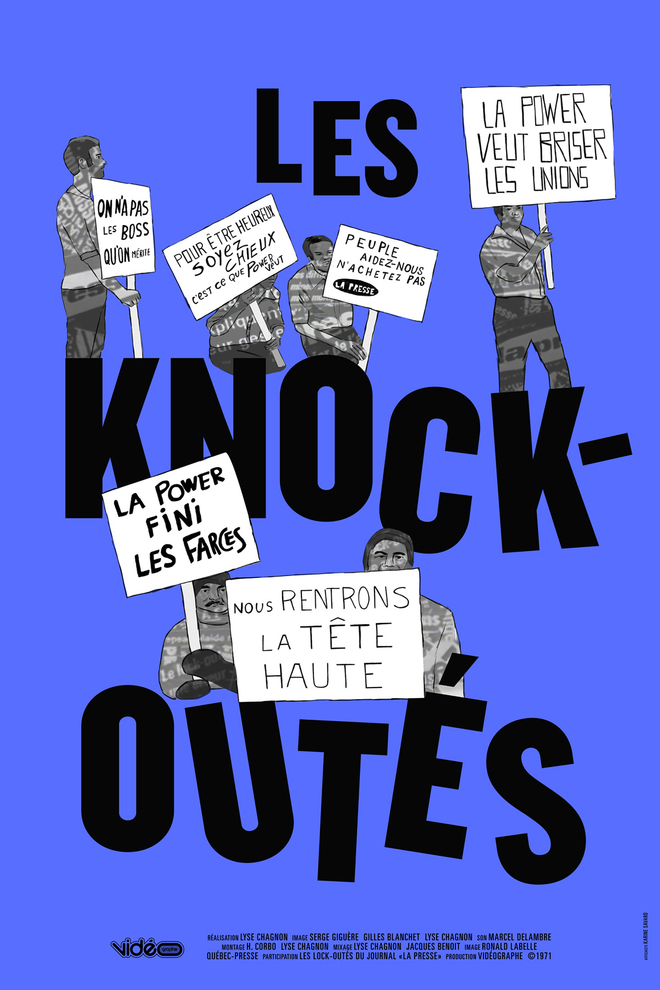
With the new modes of working, increasing numbers of workers are being confronted by what Fanny Lederlin calls ‘néotravail’ [‘neowork’], characterized by ‘the fragmentation, the depreciation and addition of (and by) work’, 27 which ‘threatens our relationship to nature, to others, to ourselves and to the world’. 28 According to the author, ‘it is no longer so much about calling for a radical reversal of capitalism by a revolutionary mobilization on the part of workers, as about encouraging the practice of a constant and painstaking discrete scuttling of today’s economic and social order, through the daily exercise of another way of working’. And so, in ‘managing their obedience of and resistance to instructions’ and ‘in remaining the sole creators of their language’, the workers can save the ‘mediating […] socialising, subjectifying and emancipating qualities of work’.29 In other words, occupying our time, space, imagination and subjectivity through a quality of gestures, considerations, learning and care allows us to expose (and affirm) the real value of our work while rejecting that which the neoliberal system requires of us, which we might accept reluctantly or through blind complicity.
NOTES
1 Polèse, Mario (2012) « Montréal économique, de 1930 à nos jours » in Histoire de Montréal et de sa région, Tome II, Montréal : Presses de l’Université Laval, p. 998, cited in Desjardins, Yves (2017) Histoire du Mile End, Montréal : Septentrion, p. 309.
2 Steyerl, Hito (2009) “Is a Museum a Factory?”, e-flux journal #07 June-August 2009.
3 Lederlin, Fanny (2020) Les dépossédés de l’open space. Une critique écologique du travail, Paris : Presses universitaires de France, p. 59-60.
4 Linhart, Danièle (2015) La comédie humaine du travail. De la déshumanisation taylorienne à la sur-humanisation managériale, Toulouse : Éditions érès, p. 31.
5 Heinish, Nathalie (2005) L’élite artiste. Excellence et singularité en régime démocratique, Paris : Éditions Gallimard, p. 149-150.
6 Menger, Pierre-Michel (2002) Portrait de l’artiste en travailleur. Métamorphose du capitalisme, Paris : Seuil, p. 8.
7 Loc. cit.
8 Lazzarato, Maurizio (2009) Expérimentations politiques, Paris : Éditions Amsterdam, p. 114.
9 Ibid., p. 58.
10 Florida, Richard (2002) The Rise of the Creative Class: And How It’s Transforming Work, Leisure, Community, and Everyday Life, New York: Perseus Book Group.
11 Rosler, Martha (2013) Culture Class, New York: e-flux and Berlin: Sternberg Press,p. 113-119.
12 Paré, Isabelle (2011) « Le plus populeux quartier d’artistes au Canada sous la pression des spéculateurs. Les avis d’expulsion menacent les artistes du Mile End », Le Devoir, 25 October 2011, p. B8, cited in Desjardins, Yves (2017) Histoire du Mile End, Montréal : Septentrion, p. 316.
13 Lederlin, Fanny (2020) Les dépossédés de l’open space. Une critique écologique du travail, Paris : Presses universitaires de France, p. 47.
14 Ibid., p. 67.
15 https://garemtl.com (consulted on 2 October 2017).
16 Foulon, Sandrine (2019) « Le retour du tâcheronnage », Alternatives économiques, 2019/9 (No 393), p. 28-29.
17 http://www.journeesansculture.ca/fr/la-jsc-un-bref-apercu (consulted on 4 December 2019).
18 Rodriguez, Pablo (2016) ‘The Artist as Entrepreneur: The Only Remaining Horizon?’ in To Spoil the Party, to Set our Joy Ablaze, Montréal: Journée sans culture. Available here: http://www.journeesansculture.ca/wp-content/uploads/2016/10/JSC_Troubler-la-fete-to-set-our-joy-ablaze.pdf p.46.
19 Byung-Chul Han (2014) La société de la fatigue, (Julie Stroz, trad.) Paris : Éditions Circé, p. 10-12.
20 Lazzarato, Maurizio (2009) Expérimentations politiques, Paris : Éditions Amsterdam, p. 28.
21 Lazzarato, Maurizio (2011) La fabrique de l’homme endetté, Paris : Éditions
Amsterdam, p. 73-74.
22 Graeber, David (2019) Bullshit Jobs, (Élise Roy, trad.) Paris : Éditions Les liens qui libèrent, p. 359.
23 Ève Lamont says that ‘in 1991-92, the ministère de la Sécurité du revenu gave more than 51 million dollars to employers who took on welfare recipients without having to hire them at the end of their internships. Among these employers were: McDonalds, Royal Bank, Jean Coutu, Dunkin Donuts, the Caisses Populaires Desjardins, Hyundai, Provigo, etc.’.
24 Sewell, William H. Jr. (1980) Work and Revolution in France. The Language of Labor from the Old Regime to 1848, Cambridge: Cambridge University Press, p. 280-283.
25 Ernaux, Annie (2008) La Place, Paris : Gallimard, p. 111.
26 Byung-Chul Han (2017) Psychopolitics: Neoliberalism and New Technologies of Power (Erik Butler, trad.) Brooklyn: Verso Books, p. 11.
27 Lederlin, Fanny (2020) Les dépossédés de l’open space. Une critique écologique du travail, Paris : Presses universitaires de France, p. 243.
28 Ibid., p. 13.
29 Ibid., p. 244-245.
VIDEOS
C’est pas un cadeau ! (1975)
Tahani Rached, Canada, C.I.Q.I.M., Tahani Rached
De fil en aiguille (1979)
M.K. Emre, Magaly Sala-Skup, Canada, Ligue des femmes du Québec
En dehors du monde (1994)
Ève Lamont, Canada, Les Productions Maison
États généraux de la culture au Québec (1973)
Jocelyne Laforce, Canada, Vidéographe
La bataille du bois (1972)
Denis Bélanger, Michel Benoît, Canada, Vidéographe
Last Call (1972)
Michel Dumont, Canada, Vidéographe
Les elles coupées (1985)
Norman Thibault, Canada, Feedback audio-visuel inc., C.S.N.
Les Knock-Outés (1971)
Lyse Chagnon, Canada, Vidéographe
Les occupations CHOM, CKJL (1972)
Anonyme, Canada, Vidéographe
L’homme du taxi (1973)
André Girard, Canada, Vidéographe
Pour faire changement (1974)
Tahani Rached, Larry Mead, Canada, Vidéographe
Trois mille fois par jour (1978)
Bernard Émond, Michel Van de Walle, Canada, GIV
Vivre sa vie (1984)
Amélie Leibl-Scholl, Johanna Zumstein, Canada, Vidéographe
CREDITS
Text: Karine Savard
Editing and revision: Jean-Philippe Boudreau
Translation: Sarah Knight
All rights reserved. © Karine Savard, 2021
Presented at Centre Diagonale in Montréal (curators: Chloé Grondeau and Anne-Marie St-Jean Aubre) from 15 April to 5 June 2021 (artdiagonale.org) and at the Musée d’art de Joliette (curators: Anne-Marie St-Jean Aubre and Maud Jacquin) from 2 October 2021 to 9 January 2022 (museejoliette.org).
Karine Savard would like to thank Roxanne Arsenault, Scott Berwick, Jean-Philippe Boudreau, Karine Boulanger, Audrey Brouxel, Violaine Charest-Sigouin, Hervé Demers, Émili Dufour, Emily Gan, Chloé Grondeau, Maud Jacquin, Robin Simpson, Anne-Marie St-Jean Aubre, Manon Tourigny, Olivia Vidmar and Sami Zenderoudi for their support and contributions to this project.
This project was realised with the support of the Canada Council for the Arts, Vidéographe and Centre Sagamie.

![]()








